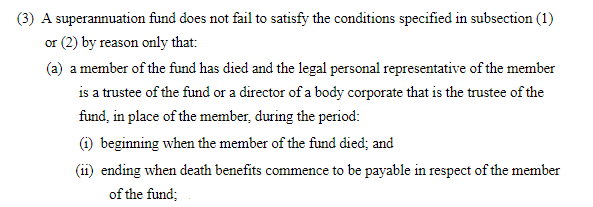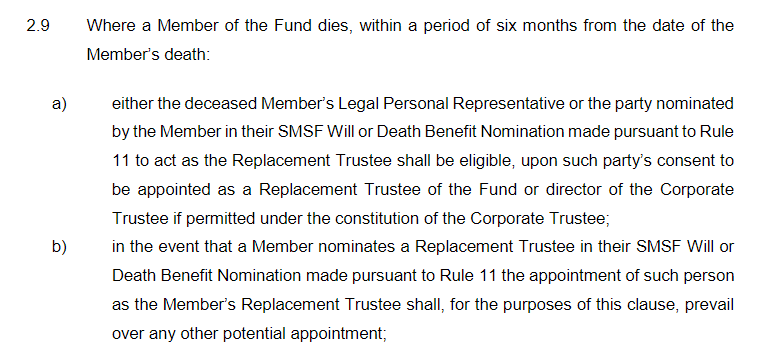The recent case of Dawson v. Dawson once again shed light on the importance of following procedure in the event of a member’s death. Similar to the decision in Ioppolo’s case, we saw that the trustee was able to demonstrate continued compliance with the definition of a SMSF within a six month time period without the need to appoint a replacement trustee/director for the deceased member.
Permissive, but not mandatory
Section 17A(3)(a) of the SIS Act allows for a legal personal representative (LPR) to step into the role as trustee/director of the deceased member in order to deal with the payment of the death benefit, however it is a permissive function, rather than mandatory, as you can see from the definition below:
certain other persons may be trustees in the event of death:

To avoid any potential conflict with this decision making role in the event of death, it is important that the fund’s trust deed provides the member with the option to nominate a replacement trustee. Many deeds will simply follow the requirements within section 17A(3)(a) of the SIS Act, which can ultimately pose some potential future risks with succession and control of death benefit payments – in particular, where there is no valid binding death benefit nomination (BDBN) in place.
Replacement Trustee
Rule 2.9 within the Smarter SMSF Deed provides either the Member’s LPR or another party nominated by the Member to act as a Replacement Trustee:

This can be achieved either through a nomination made within the Member’s SMSF Will or Death Benefit Nomination and will be eligible upon that party’s consent to act as a Replacement Trustee at the time of death. The following is an extract from the BDBN (available to order via the Smarter SMSF platform) that provides the member with the ability to appoint a Replacement Trustee to deal with their super death benefit upon their consent:

Importantly, the decision for this individual to consent to the appointment as a replacement will require the relevant reporting to the ATO and/or ASIC within the prescribed time frames.
It is not always necessary to have to appoint a replacement trustee in the event of death, in particular where the surviving member is also a trustee/director and beneficiary. There are however other times where the clarity of such appointment will be absolutely critical to seeing out the wishes of the deceased member. And that’s where you simply can’t leave such matters to chance.








